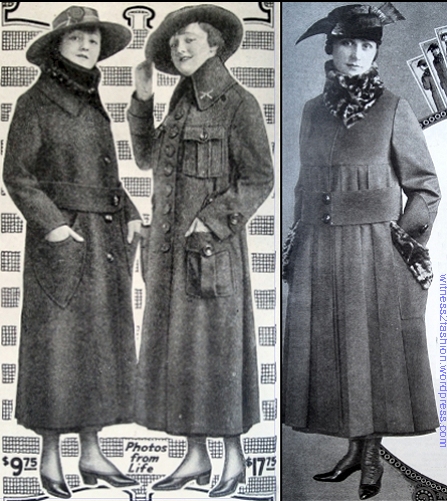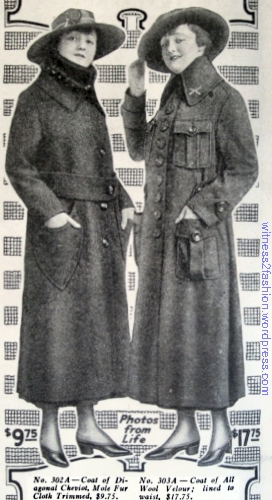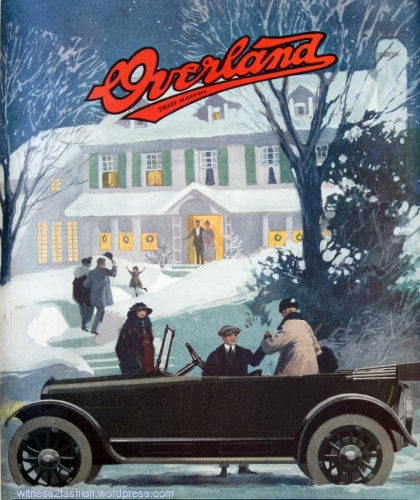
Three mail order coats advertised in Ladies’ Home Journal, October 1917. Hamilton ad, left; Printzess ad right.
Apparently, 1917 was not a year when women went around asking “Does this coat make me look fat?”

Swagger coat from Bedell clothes catalog. Advertised in Ladies’ Home Journal, Oct. 1917. For teens and women.
This ad for the Bedell’s catalog really got my attention, because it is not a “Lane Bryant Stout” ad. This coat is for teens 14, 16, and 18 years old, and for women with bust sizes 34 to 44 — the normal size range until the 1930s. “It is a stunning New York model made of excellent quality Melton cloth, delightfully warm” and trimmed with “silk caracul fur fabric [i.e., simulated fur];” “the wide cape collar . . . may be worn high or low.” The price is $9.98, with free express shipping included.
Sweaters were not very flattering, either. No one had yet realized that the camera can add pounds, so professional models were normal, pretty women. (An average model now is 5’11” and weighs less than 120 lbs. No wonder these models from 1917 seem a bit stocky to us.)

Sweater from an ad for Glossilla crochet and embroidery thread, November 1917. Ladies’ Home Journal, p. 36.
The coat below, from Wanamaker, was available in black, taupe, or navy blue and has a large cape collar of “taupe kit coney fur” [rabbit.] It cost nearly twice as much as the swagger coat from Bedell’s: $18.75.
These Hamilton coats are in the same price range as the others; the one on the left cost $9.75, and the one on the right cost $17.75.
During World War I, women’s suits and coats often showed a strong military influence, like the one above, right [are those crossed swords on her collar?] — so did their hats.

Coat pattern illustrations, Ladies’ Home Journal, Oct. 1917. Note the military-style hat on left. She could be leading a marching band.
The very full coat on the left, above, was recommended for an 18 year old girl. The one on the right was for women up to bust 44″.
Very high collars, which could be worn open or buttoned up to the chin, took some rather strange shapes when unbuttoned:

Seventeen year old girl, about 1918. Her collar could probably be fastened into the chin-high, fold-over collar seen in other illustrations. She wrote her age on the back of the photo.
The military influence (and a good deal of jingoism) led to ads like this one, for Kenyon coats and suits:

Ad for Kenyon coats and suits, October 1917. Ladies’ Home Journal. (They aren’t mud-stained; it’s a printing flaw.)
This coat, made of “high grade Bolivia cloth” and lined with “peau de cygne” [swansdown, either real or artificial] came in five colors, including “wistaria” and cost $55.00! (A Ford Runabout automobile cost $345 in 1917.)
Since most women would not be inspecting battlefields, I wondered why coats were so bulky and heavy in 1917.

Photo of coat from Ladies’ Home Journal; coat pattern illustration from Delineator. Both from October 1917. As usual, the fashion illustration idealizes the human body.
These two ads from December, 1917, gave me a clue:

“Steer Warms Keep the Hands Warm While Driving.” “Electrically heated grips” for your steering wheel. Ad, Dec. 1917, LHJ. The car has no side windows and no roof.
The Ford Model T, introduced in 1908, was by far the most popular car in America: 734,811 Fords were made in 1916. Willys-Overland was second, with 124,834. [Source: Average Guy’s Car.]
You’ll notice that cars could get very chilly.
For some time, cars were similar to the horse-drawn carriages they replaced — open to the elements.
“In 1911, Buick introduced its first closed-body car, four years ahead of Ford,” according to Wikipedia. AfterMarket News says the 1913 Hudson Model 54 was “the first U.S. automobile with a closed body. Previously, cars left their occupants completely exposed to the weather, or, at best, covered by a convertible top.” [Source: aftermarketnews.com.]
Whichever is right, in 1917, most Americans who owned a car were driving through winter rain and snow without a hard roof, glass windows, a heater, or any insulation. And American women were definitely driving cars.
If it was a winter like 2015, they needed warm coats.








